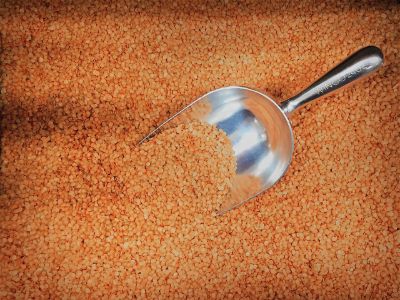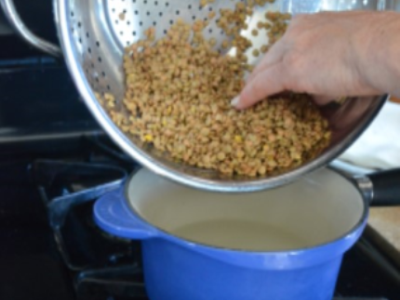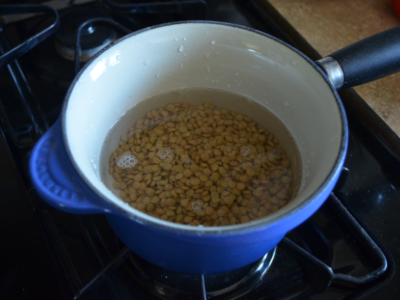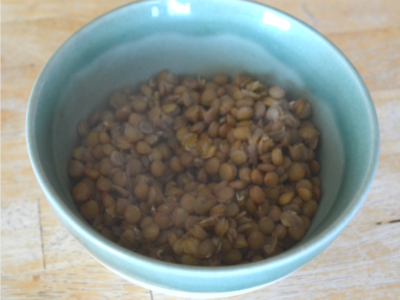Lentils

Preparation: Step-by-Step

Wash hands. Thoroughly rinse lentils to remove any dirt.
Check for rocks and other debris.

Strain lentils.
To cook, use 1 cup lentils to 1 1/2 cups water.

Add lentils to water and bring to a boil. Simmer for 15‐20
minutes for salads or longer for puree. Cooking time
varies due to variety and desired texture.

Add desired seasonings. Serve alone or use in soups,
stews or other dishes. Best chilled prior to use in salads
or purees.
Grow.
- Lentils are a cool season plant much like other legumes. Montana produces almost 40%
of U.S.
lentils. They are tolerant to frosts in the seedling stage, allowing for early planting a week or two before the
last spring frost when soil temperatures are a minimum of 40°F. In the garden, seeds should be planted at
approximately 1 inch deep about 2 inches apart. Plants can be thinned to 4‐6 inches apart and trellised if
desired. Excessive watering can kill plants which need approximately 10 inches of water throughout the
growing season. Irrigation should be stopped when pods begin to dry.
Harvest.
- Pods can be harvested green and lentils eaten much like shell peas. Dried lentils
for storage
should be harvested at approximately 80‐100 days maturity when pods have completely dried. Lentils
should be removed from pods for long‐term storage. Visit www.msuextension.org for more information or
contact your Extension office.
- French green, black, red, green, golden, and pardina (brown) are some of the many
varieties of lentils.
While every variety is versatile, each one has unique characteristics of texture,
flavor, and color. Green lentils are larger and suitable for soups, salads, and in
baked goods as a puree. Golden and red lentils cook quickly and lose their
shape, making them great for adding to sauces, to thicken soups, mashed
potatoes, or baked goods when pureed. Pardina, Black Beluga®, and French
green lentils are smaller and round, hold their shape and are great sprouted
and/or served in soups or salads.
- Store lentils in airtight containers in a cool, dry place for up to a year. Cooked
lentils may be refrigerated up to 5 days or frozen up to 3 months.
- Like other plant‐based foods, lentils contain no cholesterol, fat or sodium. Lentils
provide protein, iron, magnesium, phosphorus, zinc and
other minerals. These also contain phytochemicals which may help to reduce the risk of cancer and other diseases.
Blend.
- Add 1‐2 tablespoons cooked lentils to smoothies.
Cook.
- Use 1 cup lentils to 1 1/2 cups water. Boil for 15‐20 minutes for salads or longer for puree, depending on variety and desired texture.
Grind.
- Using a high‐powered blender, food processor, coffee/spice grinder, or flour mill,
grind washed and dried lentils until desired
consistency. Use in baked goods as a gluten‐free, high‐protein and high‐fiber flour.
Pan-Fry.
- Cooked lentils can be used to make veggie burgers, falafel or croquettes.
Puree.
- Place cooked lentils in food processor and drizzle with olive oil, add seasonings
if desired. Blend until smooth. Use puree as a dip for
vegetables, spread on sandwiches, base for croquette, patty, or baked goods.
Risotto, Soups, Stews, or Stir-fry.
- Add cooked lentils to soups, stews or rice dishes for added nutrients and texture.
Salad.
- Chill lentils after cooking. Combine with chopped vegetables, such as tomatoes and
broccoli, then toss with a balsamic or Italian
dressing. Add to a pasta or green salad for fiber and protein.
Season.
- For added flavor, cook lentils in water, broth or tomatoes. To enhance flavor, experiment
with low‐sodium seasonings such as
allspice, bay leaf, cardamom, chili powder, cloves, cumin, curry powder, garlic, ginger, nutmeg, oregano, rosemary, thyme or turmeric..
Soak.
- Cover lentils with 2 inches water, cover, and soak in refrigerator for 10‐12 hours.
Although lentils do not need to be soaked prior to
cooking like other legumes, soaking and sprouting helps to increase nutrient availability.
For More Information:
Montana State University Extension: msuextension.org
MSU Extension Master Gardener: mtmastergardener.org
MSU Extension Food and Nutrition: nutrition.msuextension.org
MSU Extension Nutrition Education Programs: buyeatlivebetter.org
Date of Publication: November 2015
